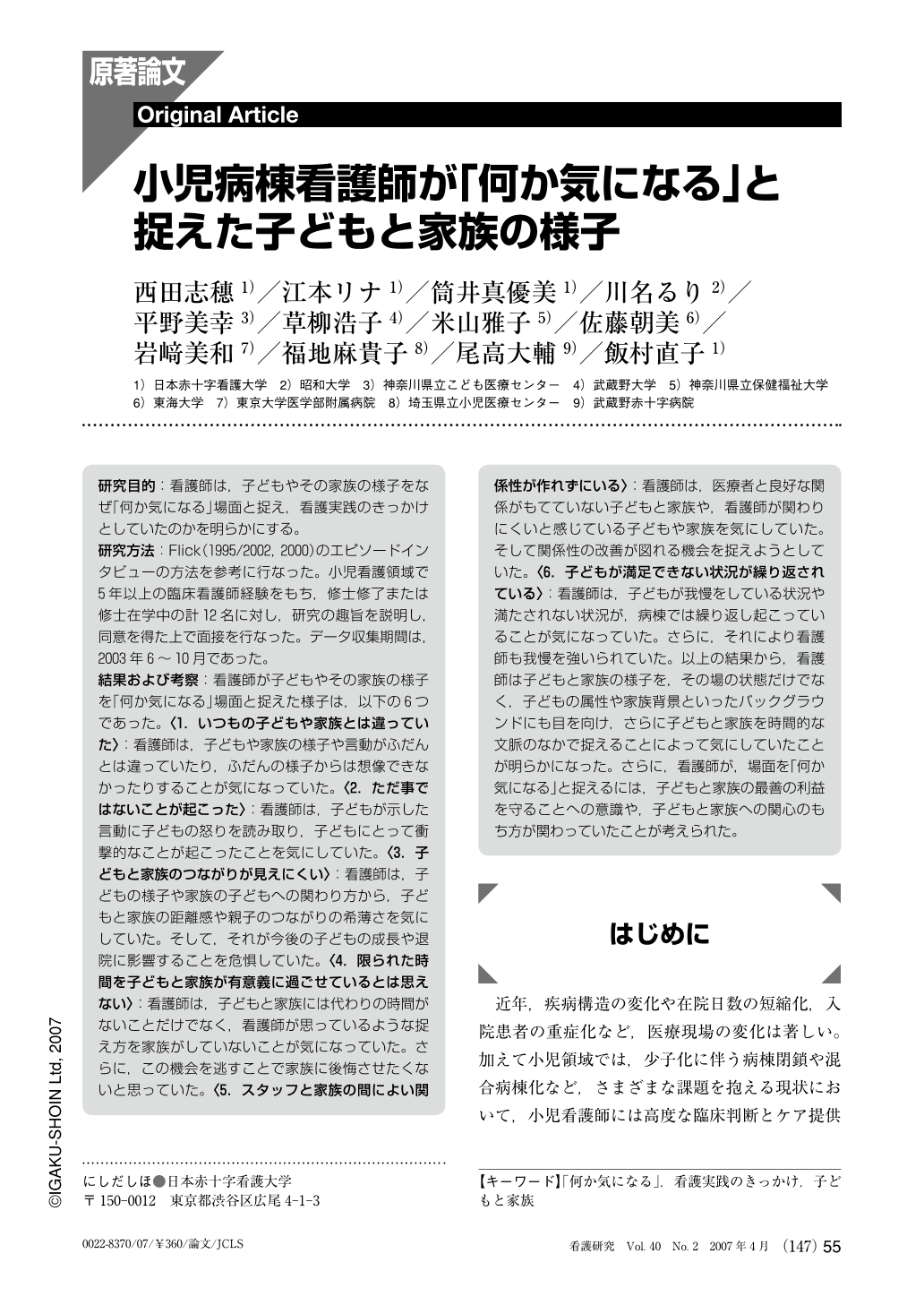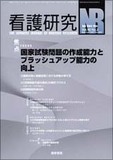Japanese
English
- 有料閲覧
- Abstract 文献概要
- 1ページ目 Look Inside
- 参考文献 Reference
- サイト内被引用 Cited by
研究目的:看護師は,子どもやその家族の様子をなぜ「何か気になる」場面と捉え,看護実践のきっかけとしていたのかを明らかにする。
研究方法:Flick(1995/2002, 2000)のエピソードインタビューの方法を参考に行なった。小児看護領域で5年以上の臨床看護師経験をもち,修士修了または修士在学中の計12名に対し,研究の趣旨を説明し,同意を得た上で面接を行なった。データ収集期間は,2003年6~10月であった。
結果および考察:看護師が子どもやその家族の様子を「何か気になる」場面と捉えた様子は,以下の6つであった。〈1.いつもの子どもや家族とは違っていた〉:看護師は,子どもや家族の様子や言動がふだんとは違っていたり,ふだんの様子からは想像できなかったりすることが気になっていた。〈2.ただ事ではないことが起こった〉:看護師は,子どもが示した言動に子どもの怒りを読み取り,子どもにとって衝撃的なことが起こったことを気にしていた。〈3.子どもと家族のつながりが見えにくい〉:看護師は,子どもの様子や家族の子どもへの関わり方から,子どもと家族の距離感や親子のつながりの希薄さを気にしていた。そして,それが今後の子どもの成長や退院に影響することを危惧していた。〈4.限られた時間を子どもと家族が有意義に過ごせているとは思えない〉:看護師は,子どもと家族には代わりの時間がないことだけでなく,看護師が思っているような捉え方を家族がしていないことが気になっていた。さらに,この機会を逃すことで家族に後悔させたくないと思っていた。〈5.スタッフと家族の間によい関係性が作れずにいる〉:看護師は,医療者と良好な関係がもてていない子どもと家族や,看護師が関わりにくいと感じている子どもや家族を気にしていた。そして関係性の改善が図れる機会を捉えようとしていた。〈6.子どもが満足できない状況が繰り返されている〉:看護師は,子どもが我慢をしている状況や満たされない状況が,病棟では繰り返し起こっていることが気になっていた。さらに,それにより看護師も我慢を強いられていた。以上の結果から,看護師は子どもと家族の様子を,その場の状態だけでなく,子どもの属性や家族背景といったバックグラウンドにも目を向け,さらに子どもと家族を時間的な文脈のなかで捉えることによって気にしていたことが明らかになった。さらに,看護師が,場面を「何か気になる」と捉えるには,子どもと家族の最善の利益を守ることへの意識や,子どもと家族への関心のもち方が関わっていたことが考えられた。
[Objective] The objectives of this study were to describe how nurses perceived there was “something to be anxious about” and the reasons why improvements in their nursing practice were necessary.
[Method] Flick's episodic interview method was used through this study. Twelve pediatric nurses, all either graduate students or master prepared, with five years of clinical experience or more, were participated in this study. They were informed of the objectives and the outline of this study and signed in.
[Findings and Discussion] The reasons why nurses recognized the situations as “something to be anxious about” were found to be categorized into six groups.
1. Children and families were out of the ordinary : Nurses were anxious about the children's and families' behaviors being out of the ordinary or inconceivable from their common manner.
2. Extraordinary things were happened : Nurses found children's anger behind their behaviors, and were anxious that the shocking events were happened to children.
3. Weakness of relations between children and families: Nurses were anxious about the weak relations between children and families. Nurses feared that these situations would affect children's development and their discharge plans.
4. It did not seem that children and families were making the most of what limited time they have together : Nurses were anxious about children and families not having an alternative occasion and recognizing the value of the limited time.
5. Difficulty in building relationships between families and nurses : Nurses were anxious about the children/families with whom nurses had having a hard time to relate and the situations which cares for children/families were difficult to do. Nurses tried to have opportunities to improve the relationships.
6. Situations that children had not been satisfied with had kept reoccurring : Nurses were anxious about the situations that kept children in patient and not being satisfied, and nurses were also frustrated.
Findings appeared that nurses recognized the situations as “something to be anxious about” by focusing on not only the children's and families' situations, but also their basic characteristics and background. It was affected how nurses recognize the situations as “something to be anxious about” by them aware protecting the best interests of children and families and concern about.

Copyright © 2007, Igaku-Shoin Ltd. All rights reserved.


